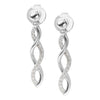Lab-Grown Diamonds
Lab-Grown Diamonds
As the name suggests, lab-grown diamonds are made in laboratories by creating the similar conditions that leads to their growth inside the earth’s crust. Some of the other common names for lab-grown diamonds are man-made diamonds, cultured diamonds and synthetic diamonds, yet, the most used names are either man-made or lab-grown diamonds.
The most common question related to lab-grown diamonds is “Are they REAL DIAMONDS?”
Well, the oft-repeated answer to this question is YES, ABSOLUTELY. But somehow, it fails to bring satisfaction and conviction in the mind of the questioner.
Perhaps, a parable might help!
Imagine the ice grown in the refrigerators and the ice dropping from the clouds in the form of hailstones. How are they different? Both are ice, both exhibit the same physical and chemical properties, both melt to form water. The only difference is that the one from the refrigerator has come into existence because of a man-made effort (in terms of reducing the temperature below 0 degrees), whereas the hailstones got created as a result of a natural process – without the intervention of any human element.
Same is the case with the lab-grown diamonds. Unlike mined-diamonds which grow as a result of natural processes, spanning over thousands of years, the lab grown diamonds are grown inside a laboratory, by creating a similar condition (with the help of advanced technology).
The result is the same – both are diamonds – exhibiting the same PHYSICAL, CHEMICAL and OPTICAL properties. The only difference is, lab-grown diamonds are ETHICAL and GUARANTEED CONFLICT FREE, whereas earth-mined diamonds are popularly known as CONFLICT DIAMONDS or BLOOD DIAMONDS.
Origin of Lab-Grown Diamonds
Scientists began working on lab-grown diamonds in the late 18th century and the early 19th century. Ever since it became known that diamond is a pure carbon structure, efforts were made to replicate the natural process, with the help of the available technology during that time.
Many names come up when discussing the origins of lab-grown diamonds, however, the name of Henri Moissan is the most popular, despite the fact that his experiment did not result in the formation of diamonds. He invented crystals that were later named after him as moissanite (discussed in the later sections), but it was a big breakthrough.
Moissanite did not have carbon in its structure, rather, it was made of silicon carbide. Later, scientists worked and took forward the study of Henri Moissan, but none of them were successful in making a diamond structure.
Back in 1941, General Electric formed a team of scientists to work on the synthesis of diamonds, however, when the Second World War broke out, all the work came to a halt and it did not resume, up until a few years after the end of the Second World War.
The year 1954 is historic in the field of lab-grown diamonds, as it was in this year, GE announced to have to have found a verified and repeatable process for diamond synthesis.
Since then, the advancement in technology has led to the formation of two major processes of creating diamonds. Both are discussed in brief in the below section.
Evolution of Lab-Grown Diamonds
DIFFERENT METHODS TO CREATE LAB GROWN DIAMONDS
As explained in the earlier section, scientists have been relentlessly working on creating diamonds in the laboratory since the late eighteenth century. And they came very close to creating one just before World War II, however the war put a halt on the research and development process and stalled the invention of the process of creating diamonds.
It was only after a few years of World War II, scientists once again focussed their attention on it, and came up with the first process in the 50s, which is popularly known as the HPHT process. Later, a new technology was developed with the name of CVD.
Chemical Vapour Deposition (CVD)
Being a relatively newer method for the formation of diamonds, CVD employs less pressure and temperature to give the desired results. Came into existence in the 80s, the CVD method involves placing a diamond seed in a vacuum chamber and then heating it to approximately 1500 degrees Fahrenheit in the presence of different carbon rich gases.
The high temperature results in the release of carbon pieces from these gases, which then gets deposited in to on and around the diamond seed, initiating the process of diamond formation.
How CVD Diamonds Are Different
One of the main advantages of using a CVD method is that one gets an extremely rare diamond that is difficult to be formed naturally under the earth’s crust. This is because, the diamond produced from the CVD method is free from different kinds of impurities and hence often categorized as the most chemically pure diamond. Being generally free from boron or nitrogen, they are of a better quality.
How Fast Do They Grow
When it comes to the growth rate, CVD diamonds are impressive. Under normal conditions, they grow at 0.1 – 10 micron-size per hour. Roughly, it takes a month to grow a 1 carat diamond using a CVD method. Also, the growth of a CVD diamond is generally in one direction as opposed to the natural diamond that grows in 8 different directions at the same time.
High Pressure High Temperature (HPHT)
High Pressure High Temperature is today the oldest method for developing diamonds. It came into existence in the 1950s and this particular method, apart from growing diamonds from scratch, is also used to enhance the colour of the diamonds to make them yellow, pink, blue, green and even colourless.
The process involves placing a small diamond seed in carbon and then applying extremely high temperature (more than 2000 degree celcius) and equally high pressure (around 1.5 million pounds per square inch). This is more or less, creating the natural situation under which diamonds are formed under the earth’s crust.
The high pressure and temperature melts the carbon and it begins to form into a diamond at the periphery of the starter seed.
How HPHT Diamonds Are Different
It is likely that HPHT diamonds will exhibit a yellow colour. This is because of the presence of nitrogen during the formation, gives a yellow hue to the diamond crystal. Apart from it, the inclusions in the diamond structure are darker, because of the presence of metallic impurities. These metallic impurities further make the stones magnetic in nature. With the HPHT method, it is almost impossible to create a colourless diamond, because of the presence of impurities in the form of nitrogen and boron that give it either a yellow or a blue colour.
IMPROVEMENT IN QUALITY OF LAB GROWN DIAMONDS
The best part of technology is that it doesn’t remain constant, rather it keeps on getting better and more advanced, while the cost takes the similar, but downward trend. The technology that led to the birth of lab-grown diamonds have also passed through the same phase and it is now in such a position that we can get amazingly quality and big size diamonds at a relatively cheaper cost.
According to an eye-opening report by Bain, the cost of developing a lab-grown diamond has come down to meagre $300 – $500 per carat (using the CVD method), from the earlier $4000 per carat back in 2008.
Right from the 1950s up until now, there has been a lot of changes in the way the diamond was made in the laboratories and their quality in terms of clarity, carat, and colour.
It is now possible to create diamonds of any colour or even colourless. High quality diamond is also possible and the largest size lab-grown diamond that has been created till date is 155 carat, which stretches upto 4 inches in width.
Acceptability and Trend of Lab-Grown Diamonds
The Rising Trend
Lab-grown diamonds are not something of a recent origin, but it is only in the past 2 decades that they have become quite popular. They are also referred to as man-made or cultured diamonds because of the fact that they are not extracted from the earth’s crust using energy extensive methods responsible for the destruction of the entire ecosystem.
Today the market share of lab grown diamonds is 2-3 per cent of the $14 billion rough diamond market. It is a good over 100% jump since 2016, when lab grown diamonds were just 1% of the entire diamond trade. And it is estimated that in the near future, their demand will witness a sharp increase.
In terms of net worth, lab grown diamonds stood out at $1.9 billion in 2018 and it is expected to grow 22 percent annually to $5.2 billion by 2023 and $14.9 billion by 2035.
The diamond trade has continued to remain bloody and dirty right from the 50s, however it was not until 2006 that general people became aware of it. Leonardo DiCaprio’s movie “Blood Diamond” in 2006 exploded the dark truth behind the world of glittering diamonds and made people a little uncomfortable about them.
Since then, many earnestly began to look out for a diamond alternate and lab-grown seemed to be the only option. And interestingly, the technology has made lab-grown diamonds far far better than the mined diamonds.
The Acceptability
Interestingly, women are not shying away from lab-grown diamonds. In fact, the acceptability of lab-grown diamonds is rising exponentially and more and more women are expressing their desire to have their engagement and wedding ring made of lab-grown diamonds only.
The celebrities have played a big role too, in terms of raising awareness about lab-grown diamonds. Right from Penelope Cruz to Meghan Markle and from Emma Watson to Lady Gaga, the ladies have made a strong argument that for them the ETHICAL TRIUMPHS OVER THE DESTRUCTIVE.
Nikki Reed and Ian Somehalder who got married in 2015, had made their engagement ring using cultured diamonds. The acceptability of lab grown diamonds is overwhelming and opinion polls are speaking for this rising trend, loud and clear.
A recently conducted poll by Berenber Research, comprising 2000 female millennials found out that 53% women would readily accept an engagement ring made of lab-grown diamonds. The figures were relatively high in Japan touching the 62 mark, whereas in the US, the percentage came out as 56%.
With each passing day, the ecological crisis is unfolding to new levels, highlighting the importance of going for lab-grown diamonds that are ETHICAL, ECO-FRIENDLY and SLAVERY FREE.












